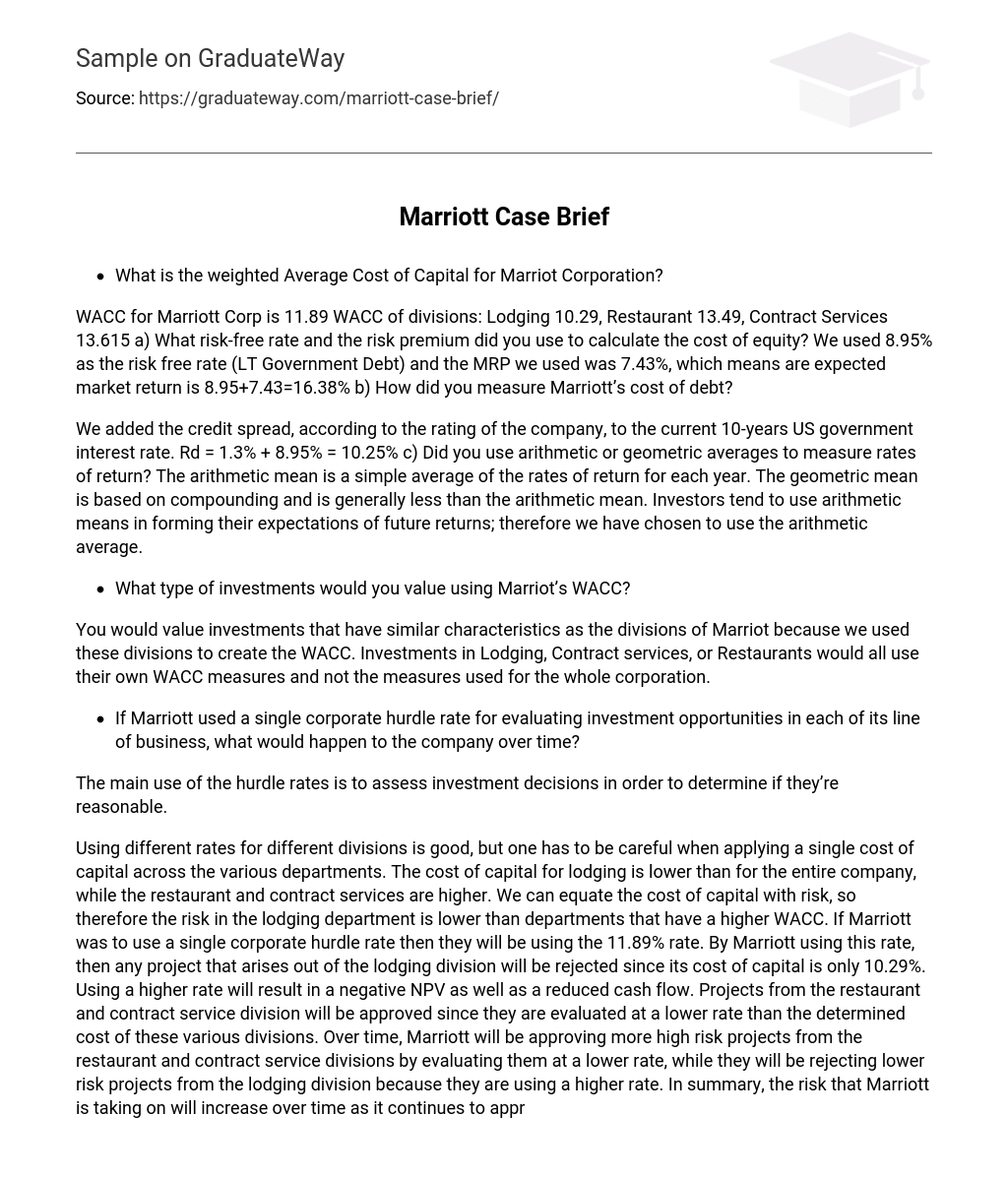- What is the weighted Average Cost of Capital for Marriot Corporation?
WACC for Marriott Corp is 11.89 WACC of divisions: Lodging 10.29, Restaurant 13.49, Contract Services 13.615 a) What risk-free rate and the risk premium did you use to calculate the cost of equity? We used 8.95% as the risk free rate (LT Government Debt) and the MRP we used was 7.43%, which means are expected market return is 8.95+7.43=16.38% b) How did you measure Marriott’s cost of debt?
We added the credit spread, according to the rating of the company, to the current 10-years US government interest rate. Rd = 1.3% + 8.95% = 10.25% c) Did you use arithmetic or geometric averages to measure rates of return? The arithmetic mean is a simple average of the rates of return for each year. The geometric mean is based on compounding and is generally less than the arithmetic mean. Investors tend to use arithmetic means in forming their expectations of future returns; therefore we have chosen to use the arithmetic average.
- What type of investments would you value using Marriot’s WACC?
You would value investments that have similar characteristics as the divisions of Marriot because we used these divisions to create the WACC. Investments in Lodging, Contract services, or Restaurants would all use their own WACC measures and not the measures used for the whole corporation.
- If Marriott used a single corporate hurdle rate for evaluating investment opportunities in each of its line of business, what would happen to the company over time?
The main use of the hurdle rates is to assess investment decisions in order to determine if they’re reasonable.
Using different rates for different divisions is good, but one has to be careful when applying a single cost of capital across the various departments. The cost of capital for lodging is lower than for the entire company, while the restaurant and contract services are higher. We can equate the cost of capital with risk, so therefore the risk in the lodging department is lower than departments that have a higher WACC. If Marriott was to use a single corporate hurdle rate then they will be using the 11.89% rate. By Marriott using this rate, then any project that arises out of the lodging division will be rejected since its cost of capital is only 10.29%. Using a higher rate will result in a negative NPV as well as a reduced cash flow. Projects from the restaurant and contract service division will be approved since they are evaluated at a lower rate than the determined cost of these various divisions. Over time, Marriott will be approving more high risk projects from the restaurant and contract service divisions by evaluating them at a lower rate, while they will be rejecting lower risk projects from the lodging division because they are using a higher rate. In summary, the risk that Marriott is taking on will increase over time as it continues to approve high risk projects from the restaurant & contract services division.
- What is the cost of capital for the lodging and restaurant divisions of Marriott?
a) What risk-free rate and risk premium did you use in calculating the cost of equity for each division?
Why did you choose these numbers? We decided to use 8.95% risk free rate because we believed that Marriott will get 30 years of usage from it and it was also the longest term division as well. For restaurant & contract services, we used 8.72% because it was stated that the restaurant & contract services would have shorter useful lives or at least 10 years we assumed. As 7.43% risk premium is the spread between S&P500 composite returns, we decided to use this number for lodging business because it has pretty long term rates and long-term government bond returns. For restaurant and contract service business, we decided to use 8.47% because they have a pretty short term rates.
b) How did you measure the cost of debt for each division? Should the debt cost differ across divisions? Why?
The cost of debt was calculated as the 30 year risk free rate + the premium or 8.95% + 1.10% = 10.05% before tax cost of debt for lodging division. We also decided to use the 10 year risk free rate + the premium or 8.72% + 1.80% = 10.52% for the restaurant division. This is because we assumed the lodging and restaurant division would definitely need to have different debt cost across the division as the lodging would have a useful life of 30 years and the restaurant would have a useful life of 10 years. Therefore you would have compare them with the similar duration/maturity government rates to the divison.





